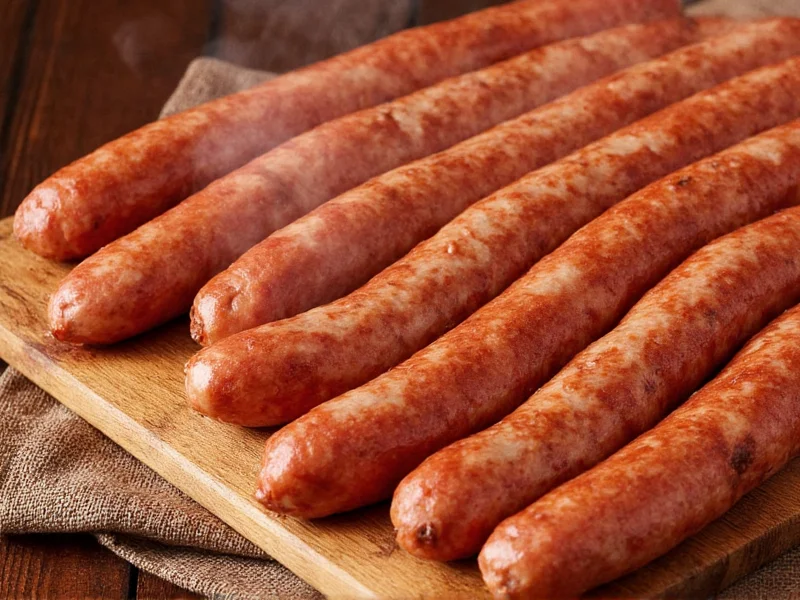The safe internal temperature for cooked sausage is 160°F (71°C) for pork, beef, and lamb varieties. For chicken and turkey sausages, the required temperature is higher at 165°F (74°C). These temperatures ensure harmful bacteria like Salmonella and E. coli are eliminated, making your sausage safe to eat while maintaining optimal texture and flavor.
When cooking sausage, temperature accuracy isn't just about preference—it's a critical food safety requirement. Undercooked sausage can harbor dangerous pathogens that cause foodborne illnesses, while overcooked sausage becomes dry and unappetizing. The United States Department of Agriculture (USDA) Food Safety and Inspection Service establishes these temperature guidelines based on extensive scientific research to protect consumers.
Why Temperature Matters More Than Color
Many home cooks mistakenly rely on sausage color to determine doneness. However, visual cues can be misleading. Sausage may appear browned on the outside while remaining dangerously undercooked inside. Conversely, certain sausages containing nitrites might retain a pink color even when fully cooked. Only a food thermometer provides reliable confirmation that your sausage has reached a safe internal temperature.
Sausage Temperature Guidelines by Meat Type
| Sausage Type | Safe Internal Temperature | Resting Time |
|---|---|---|
| Pork, Beef, Lamb Sausages | 160°F (71°C) | 3 minutes |
| Chicken, Turkey Sausages | 165°F (74°C) | 3 minutes |
| Pre-cooked Smoked Sausages | 140°F (60°C) | Not required |
Proper Thermometer Technique for Accurate Readings
Using a thermometer correctly is essential for accurate temperature measurement. Insert an instant-read thermometer into the thickest part of the sausage, avoiding contact with the cooking surface or bone. For links, pierce sideways through the center. For patties, insert through the edge into the center. Digital thermometers provide the most precise readings in the shortest time.
Calibrate your thermometer regularly by testing it in ice water (should read 32°F/0°C) or boiling water (212°F/100°C at sea level). This ensures your temperature readings remain accurate over time, which is particularly important when cooking sausage to the proper internal temperature.
Common Sausage Cooking Methods and Temperature Tips
Stovetop cooking: Brown sausage links or patties over medium heat, turning occasionally. Check temperature during the last few minutes of cooking. Most sausages require 15-20 minutes total cooking time.
Grilling: Cook over indirect heat initially, then finish over direct heat for browning. Use a thermometer to verify doneness rather than relying on grill time alone, as sausage thickness and grill temperature variations affect cooking time.
Oven baking: Bake at 375°F (190°C) for 20-25 minutes, checking temperature during the last 5 minutes. Thicker sausages may require lower temperatures and longer cooking times to reach proper internal temperature without burning the exterior.
Resting Time: The Critical Final Step
After reaching the target temperature, remove sausage from heat and let it rest for 3 minutes. During this time, residual heat continues to cook the sausage slightly (carryover cooking), and juices redistribute throughout the meat. This resting period ensures your sausage maintains moisture while reaching complete safety.
Food Safety Considerations When Cooking Sausage
Always follow proper food handling practices when preparing sausage. Keep raw sausage separate from other foods to prevent cross-contamination. Wash hands, utensils, and surfaces that contact raw meat. Never partially cook sausage and refrigerate it to finish cooking later, as this creates ideal conditions for bacterial growth.
When cooking sausage for vulnerable populations—including young children, elderly individuals, pregnant women, and those with compromised immune systems—adhere strictly to the recommended temperatures. These groups face higher risks from foodborne illnesses, making precise temperature monitoring even more critical when determining what temperature sausage should reach before serving.
Common Mistakes to Avoid
Mistake: Cutting into sausage to check doneness
Solution: This releases juices and dries out the sausage. Use a thermometer instead.
Mistake: Relying solely on cooking time
Solution: Sausage thickness, starting temperature, and cooking method affect time needed to reach safe internal temperature.
Mistake: Not checking multiple pieces
Solution: Check several sausages in a batch, as they may cook at different rates.
Mistake: Ignoring resting time
Solution: Allow proper resting time after sausage reaches target temperature for optimal safety and texture.
Special Considerations for Different Sausage Types
Fresh sausages: Require full cooking to 160°F or 165°F depending on meat type. These include bratwurst, Italian sausage, and breakfast links.
Smoked sausages: Often pre-cooked but should still be heated to 140°F for safety and optimal flavor. Examples include kielbasa and andouille.
Cured sausages: Some dry-cured sausages like salami are safe to eat without cooking, but always check packaging instructions.
Understanding the specific type of sausage you're preparing helps determine the appropriate target temperature. When in doubt about what temperature sausage should be cooked to, default to the higher safety standard for the primary meat ingredient.











 浙公网安备
33010002000092号
浙公网安备
33010002000092号 浙B2-20120091-4
浙B2-20120091-4